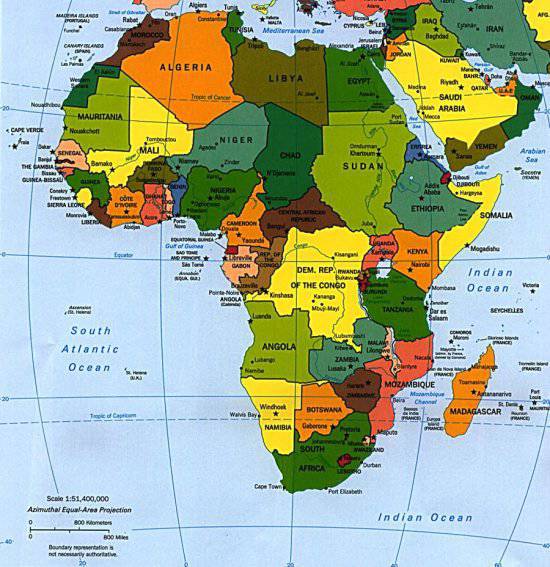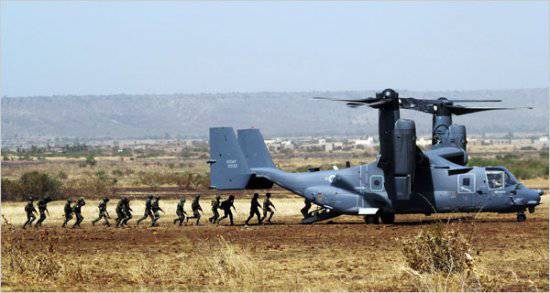Modern US military interests in African countries
Most of Africa gained “independence” after World War II, 1960 is considered the Year of Africa. This year, the "freedom" received 13 states. Most of them are former French colonies and trust territories of the UN, which were under the administration of France. Such countries as Cameroon, Togo, Malagasy Republic, Congo (formerly French Congo), Dahomey, Upper Volta, Ivory Coast, Chad, Central African Republic, Gabon, Mauritania, Niger, Senegal, Mali. Independence gained Nigeria (the largest country in terms of population, owned by London, the Belgian Congo, the largest in size territory.
Currently, these countries rarely fall into the lens of the world's media (or misinformation?). Is it possible that the report will be shown how war broke out somewhere, there was a coup, elections were held, they like to show nature.
One of these "forgotten" countries of Mali. Mali is a “former” French colony, a seemingly rather prosperous country, in the last 15 years there have been no wars, rebellions of genocides, or coups characteristic of Black Africa. There are all signs of a democratic country: democratic elections, social stability and economic growth of more than 10% per year.
But one fact is already alarming - the US has a military base in Gao, there are American soldiers in neighboring Niger, and the entire northern deserted part of Mali is occupied by the Mauritanian army with the consent of the democratically elected government of Mali.
While the USSR was on the planet, military strategic interests prevailed in the United States. In practice, this resulted in the creation of new and improvement of old military bases.
1 January 1983. The Central Command (CENTCOM) was established, the scope of which at 2002 covered the territory of 25 countries, including 11 of African states (Egypt, Djibouti, Kenya, Somalia, Republic of Mauritius, Republic of Seychelles, Sudan, Tanzania, Uganda, Ethiopia and Eritrea). Speaking at 22 in December of 1983 in Congress, US Secretary of Defense C. Weinberg spoke of a global US strategy of "deploying forces at the front lines."
This command, as well as other strategic US military commands, plays an important role in the imperial style of the American administration. We are talking about the protection of strategically important land, sea and air communications, which in the case of hostilities could be used to transport troops and cargo. In addition, we are talking about protecting the ways of delivering raw materials that are vital for the American economy from the encroachments of the potential adversary (s) in any international conflict in which the United States and its NATO allies are involved.
In practical terms, this has been translated into construction, or the modernization of existing military bases for various purposes. In Egypt, these are Cairo West, Wadi Kena, Luxor, Aswan, Ras Banas (on the Red Sea coast), military installations in the Farafra oasis, near Mersa Matruh and in the Alamein region (on the Mediterranean coast); in Kenya - the water area of the port of Mombasa has been modernized for receiving large ships; Somalia - reconstructed airfield and port in Berbera; in Sudan, military bases in Soakin (on the Red Sea), El Fasher (near the borders with Libya and Chad) and in Dongol (north of Khartoum); in Djibouti, by special agreement, the United States gained access to the French base in that country; in Morocco - military sites in Tangier, Sidi Yahya, Sidi Bouknadela, Ben-Gerira, Ben Slimane. An agreement on "strategic agreement" was reached between the USA and Morocco.
It was assumed that all these bases and objects are intended for "rapid deployment forces", which will be used both within the framework of CENTCOM and the Strategic Command of American forces in Europe. Their operational responsibility area includes Algeria, Angola, Benin, Botswana, Burkina Faso, Burundi, Cameroon, Cape Verde, CAR, Chad, Congo (Brazzaville), Cote d'Ivoire, Equatorial Guinea, DRC, Gabon, Gambia , Ghana, Guinea-Bissau, Lesotho, Liberia, Libya, Malawi, Mali, Mauritania, Morocco, Mozambique, Namibia, Niger, Nigeria, Rwanda, Sao Tome and Principe, Senegal, Sierra Leone, South Africa, Swaziland, Tanzania, Tunisia , Uganda, Zambia and Zimbabwe.
On about. Diego Garcia (the Chagos Archipelago in the Indian Ocean) built bases of the Air Force and Navy, capable of receiving strategic bombers B-52 and nuclear submarines. In a combat situation, these objects have already been used three times: in 1991, during Operation Storm in the Desert against Iraq, in 2001, during combat operations against the Taliban regime in Afghanistan. In 2003, during the military occupation of Iraq - "Iraqi Freedom".
With Zaire (now DRC) on 1983. an agreement was concluded on the construction on its territory of an air force base and a cruise missile testing ground.
With the 90-ies in connection with the change in the overall global situation (the collapse of the USSR and the Warsaw bloc), Washington took the military-political aspect in the first place in the US strategy in Africa. During this period, the United States focused on the formation of an "inter-African peacekeeping force".
In August, the Pentagon 2001 developed a "Strategy for Sub-Saharan Africa". Its essence: the participation of the US armed forces in ensuring the supply of strategic mineral raw materials from African countries (primarily oil, as well as gold, diamonds, copper, bauxite, uranium, manganese and cobalt); in the fight against organized crime and drug trafficking; in peacekeeping operations; in the fight against the spread of acute infectious diseases (especially AIDS).
The terrorist attacks of September 2011 made North Africa the “second front” against terrorism.
The Pentagon has developed and is actively implementing a number of programs for African countries:
The first concerns the activities of the Combined Joint Task Force - Horn of Africa. Its task is to fight the cells of Al-Qaida and its supporters in East Africa - in Djibouti, Eritrea, Ethiopia, Kenya, Somalia, Sudan, and also in Yemen. More than a thousand fighters from the US Special Forces participate in ground operations. Coastal waters are patrolled by the United Special Combat Group: in its composition are warships from the USA, Germany, Spain and the United Kingdom. Along with this, a special air squadron operates in the region and is designed to search and destroy "terrorist targets" from the air. In the Republic of Djibouti, there is Radio Sawaa radio station, which broadcasts around the clock in Arabic to Sudan and the countries of the Middle East. The country is one of the largest African recipients of US military aid.
The second regional security program in Africa is the Pan-Sahel Initiative (Pan-Sahelian Initiative). Initially, four countries participated - Chad, Mali, Mauritania and Niger. Its goal is to prevent terrorists from the already mythical al-Qaida, "who left Afghanistan after the American military action, and create in Iraq in these states" well-armed and trained groups of Islamic militants who receive ample funding from their patrons. "
In practice, the implementation of this initiative takes place in the form of the participation of US Special Forces units in joint operations with local armed forces - primarily in the search and destruction of so-called. "Islamic terrorists" (in this category, any enemies of the local pro-Western regimes are quickly recorded). Active US-African units are equipped with army trucks and special equipment that allows you to quickly determine the exact location of objects to strike (Global Positioning System). These units have already conducted several successful operations, the most prominent of which was to seize the leaders of an organization based in Algeria called "Groupe Salafiste pour la Predication et le Combat".
Subsequently, based on intelligence information, the US Department of Defense concluded that the Pan Sahel Initiative should be extended to more African countries than was intended in 2001. As a result in 2005 this program was transformed into the Trans-Saharan Counter Terrorism Initiative. Its action was extended, in addition to the four African states mentioned earlier, also to Algeria, Morocco, Tunisia, Senegal and Nigeria. Moreover, for the US military plans in this region, the participation of Senegal, the “most important French-speaking partner” of the United States in sub-Saharan Africa, as well as Algeria, where trans-Saharan travel routes intersect, was of particular value.
To implement this Initiative, the US Congress in 2005 allocated 500 million dollars for 5 years (by 100 million per year). Officially, this program was launched in June 2005goda, when joint military maneuvers of US special forces and units of all African states affected by the indicated Initiative, called "Flintlock 2005", were conducted.
The third program of a military nature was launched in 2003g. and was called the Anti-Terrorism Initiative in East Africa (East Africa Counter-Terrorism Initiative). It covers Djibouti, Eritrea, Kenya, Tanzania and Uganda. This program is controlled by the US Department of State, which provides its funding - 100 million dollars a year. Its goal is to destroy the al-Qaida terrorist network in East Africa created over the years. Prevent a repetition of situations in this region, like an attack on the US embassies in Kenya and Tanzania in 1998, on Israeli tourist sites in Mombasa in 2002. This program is implemented by the Safe Skies for Africa Initiative, which ensures air traffic in the region.
African countries are prioritized for the USA:
- The first group is the states of North and Northeast Africa, since they are directly adjacent to the Middle East, in which the US strategic interests are concentrated.
- The second group, large African countries ("regional centers of power"), which support the policy of the United States, "the fight against terrorism." These are South Africa, Nigeria, Algeria, Ethiopia, Kenya, Senegal.
- The third group is mainly the “raw material zones” of the West, the oil producing country of the Gulf of Guinea. They are important from an economic point of view.
- The fourth group, countries where there are no large natural resources, the United States, show occasional interest in them.
In addition to these three programs The United States pursues a focused policy of military-technical cooperation.
It is primarily about The International Military Education and Training (IMET) Program. African countries send their troops to the United States for training. So, along with a purely military orientation, this program also has political significance. Returning to their countries, African soldiers receive education in the spirit of worshiping America’s power, politics and culture and, if they take part in a military coup (which often occur in African countries), inevitably become agents of American politics in Africa. In 2005, 41 was an African country participating in this program, in 2006, in 45 already in sub-Saharan Africa. In addition to Libya, North African countries also participate in this program.
Another program is Foreign Military Financing Program-FMF. Its goal is to provide US-friendly US military equipment and equipment. In the 2006 year, 8 African countries participated in this program: Egypt, Tunisia, Morocco, Djibouti, Eritrea, Ethiopia, Kenya and Uganda.
In 2006, Washington put into operation the Global Peace Operations Initiative (GPOI), which applied to African countries, took the form of the ACOTA program (Assistance in training in antiterrorist operations in Africa or African Contingency Operations Training and Assistance - ACOTA). This program has replaced the Africa Crisis Response Initiative (ACRI) or the African Crises Response Initiative that has been in place since 1996. The main difference of the ACOTA program from ACRI is that it aims to prepare military personnel for offensive operations in the Horn of Africa (CJTE-HOA Initiative), in Eastern Africa (EACTI Initiative) and in the Pan-Sahel region (PSI and TSCTI Initiatives ). The main recipients of military-technical and financial assistance in the framework of the ACOTA program are Mali, Niger, Ethiopia, Kenya, and Uganda.
Created the command of the US armed forces in Africa (AFRICOM).
The reasons for the great activity of the United States in Africa
- The rich resources of many countries (for example: Nigeria);
- rivalry with China, for the possession of resources;
- not developed statehood of "black" states, the "elite" easily goes to serve the "white masters", it can change at least every month.


Information